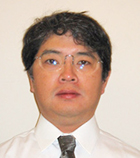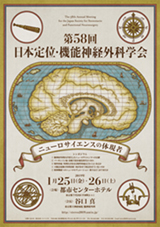
連絡事務局
株式会社 コンベックス
〒105-0001
東京都港区虎ノ門 5-12-1
虎ノ門ワイコービル
TEL : 03-5425-1602
FAX : 03-5425-1605
E-mail :
stereo2019@convex.co.jp
English
Greeting
The 58th Annual Meeting of the Japan Society for
Stereotactic and Functional Neurosurgery (JSSFN)
President: Makoto Taniguchi, MD, PhD
Director of Neurosurgery
Tokyo Metropolitan Neurological Hospital (TMNH)

It is a privilege to be able to address you as the new president, and a distinct honor to me and my colleagues on the Tokyo Metropolitan Neurological Hospital (TMNH) stereotactic and functional neurosurgery team to serve as the hosts of the 58th annual meeting of the Japanese Society of Stereotactic and Functional Neurosurgery (JSSFN) in Tokyo.
I would like to begin my remarks with a brief history of the TMNH, my own involvement with the institute, and the mission of our Society.
TMNH was established in 1980 and has served as the premier facility for stereotaxic surgery in Tokyo. Professors Hirotaro Narabayashi and Chihiro Ohye contributed to the basic design of the operating room used for this purpose, and the two former chairmen of the TMNH, professors Buichi Ishijima and Hiroshi Takahashi, helped organized the 25th and 45th of the annual JSSFN meeting in 1986 and in 2006, respectively.
I joined TMNH in 1985 as a resident. At that time, even at TMNH, the number of functional stereotactic surgeries performed was quite small. There were only a few cases of thalamic surgery for essential tremor every year. I did not imagine that I would return here and work as a stereotactic and functional neurosurgeon. The 1980s’ was the era of diagnostic neuroimaging. The CAT Scan became widespread in Japan, and the first clinical study in our country using magnetic resonance imaging (MRI) was launched at the University of Tokyo. The impact of these neuroimaging modalities has been enormous; they gave us the feeling that neurological disorders could be visualized and all the neurosurgeons had to do was to get rid of the visible targets. Meanwhile, stereotactic and functional surgery relied on ventriculography and atlases. As a young neurosurgical resident, I had the impression that stereotactic neurosurgeons targeted ‘invisible’ structures by relying on their experience. I was also not fully convinced of the safety of lesioning procedures at the time.
Needless to say, the theory and technology behind stereotactic and functional surgery are a great deal more advanced today than they were in the ‘80’s. I returned to TMNH in 1997. During my absence of ten years, many drastic changes had taken place in this field. I was able to witness the before and after states of patients at TMNH thanks to progress in these forms of treatment. In 1992, Laitinenn reported a case of posteroventral pallidotomy, which caused a renaissance in stereotactic and functional neurosurgery. The pallidotomy and other forms of stereotactic surgery were advanced as therapeutic options for patients with advanced Parkinson’s disease. MRI targeting also gave us a novel targeting method, and deep brain stimulation (DBS) offered the promise of being an effective procedure for various types of neurological disorder. DBS at that time was on the verge of being introduced to Japan.
These changes in stereotactic and functional neurosurgery coincided with the collapse of the Berlin wall, which I personally observed while I was in Germany to study neurophysiology in ###. Though of course these events are unrelated, I nonetheless felt the bewildering rapidity of change both in politics or medicine. In the subsequent 20 years, classic stereotaxic surgery for Parkinson’s disease and tremors has undergone a revival with DBS. In addition, pallidal DBS for generalized dystonia has also become established with progress in international research on dystonia. In keeping with these changes, TMNH has established a splendid multidisciplinary team for the treatment of these disorders.
Currently, functional neurosurgeons are also expected to be clinical scientists familiar with the latest developments in neuroscience. We are adventurers on a quest to understand the function of the brain, a still largely new and unknown world. We are also, in a way, a bridge from the lab stool to the patient’s bedside. The JSSFN serves as a gathering place and forum for us, active functional neurosurgeons. I like to compare the neurosurgeon to the medieval sailor; both are motivated by their powerful curiosity, inquiring mind, and adventurous spirit to explore uncharted territory. In my design of the convention poster, I made the brain atlas resemble a medieval nautical chart to express this sense of excitement and adventure.
The upcoming annual JSSFN meeting in Tokyo is scheduled for January 25-26, 2019. The main theme of the meeting is “Neurosurgeons’ Contributions to Neuroscience", and discussions will center on the past, present, and future contributions of our colleagues in neuroscience. At the movement disorder symposium, discussion will focus on "DBS in the multimodal treatment era for Parkinson's disease”. It has been nearly 20 years since DBS therapy for advanced stage Parkinson's disease was introduced to Japan. Meanwhile, new treatment modalities have been developed, and we will invite guest speakers to discuss continuous dopaminergic stimulation and future vistas in surgical interventions for patients with Parkinson’s disease. We also hope to discuss the possible roles for, and teamwork by, neurologists and neurosurgeons in the long-term postoperative care of patients with Parkinson’s disease.
In the pain symposium, discussion will focus on pain surgery, a theme familiar to functional neurosurgeons but one that continues to progress. The late 1990’s and early 2000 brought new insights into the mechanisms of pain, especially neuropathic pain. However, the recent widespread use of non-opioids has led to serious social issues, such as patients over-dosing on these medications. Neurosurgeons have invented various surgical techniques to treat refractory pain disorders, such as microvascular decompression, DREZ-lesion, and midline myelotomy. I anticipate that future pain surgery will be a vital therapeutic option in the field of pain medicine and look forward for your abstracts for this symposium as well.
Earlier this year, we held a psychiatric surgery symposium and at our last meeting in Nara, we discussed current psychiatric surgical techniques. At this year’s meeting, we will focus on the clinical goals of psychiatric surgery with guest psychiatrists and medical ethicists leading the discussion.
In addition, we are preparing another movement disorder symposium focusing on various types of dystonia, including pediatric dystonia, with a keynote guest speaker from pediatric neurology. We welcome applicants to these symposia from among the general membership. I encourage you to send in your abstracts for these exciting symposia and become an active member of our organization.
I am confident that the upcoming JSSFN annual meeting will be exciting, fertile, and thought-provoking, with lots of intense, interdisciplinary discussion from all the attendees. I look forward to seeing you at the meeting.
General Information
| Date | Friday, January 25 – Saturday, January 26, 2019 |
|---|---|
| Venue |
Toshi Center Hotel Tokyo 2-4-1 Hirakawa-cho, Chiyoda-ku, Tokyo 102-0093 Japan Tel: +81-3-3265-8211 Fax: +81-3-3262-1705 |
| President |
Makoto Taniguchi, MD, PhD Director of Neurosurgery Tokyo Metropolitan Neurological Hospital (TMNH) |
| Meeting Theme | Neurosurgeons’ Contributions to Neuroscience |
| Secretariat |
c/o Convex Inc. Toranomon Waiko Bldg., 5-12-1 Toranomon, Minato-ku, Tokyo Tel: +81-3-5425-1602 Fax: +81-3-5425-1605 E-mail: stereo2019@convex.co.jp |
Program at a Glance
Call for Abstract
| Title | within 25 words |
|---|---|
| Text | within 600 words |
Please send your abstract in word file to the meeting secretariat to stereo2019@convex.co.jp by November 11, 2018.
Invited Speakers
(Titles omitted, listed in no particular order)
Jens Volkmann
(Direktor der Neurologie, Universitätsklinik Würzburg, Germany)
Bart Nuttin
(Professor at KU Leuven, Neurosurgeon UZ Leuven, Belgium)
Veerle Visser-Vandewalle
(Direktorin der Klinik für Stereotaxie und Funktionelle Neurochirurgie, Universitätsklinikum Köln, Germany)
Ludvic Zrinzo
(Neurosurgery, UCL Unit of Functional Neurosurgery / National Hospital for Neurology & Neurosurgery, United Kingdom)
Hagai Bergman
(Hebrew University of Jerusalem, Department of Physiology, Israel)
Harith Akram
(Neurosurgery, UCL Unit of Functional Neurosurgery / National Hospital for Neurology & Neurosurgery, United Kingdom)
Uli Mezger
Clinical Marketing Manager Asia-Pacific
Katsuo Kimura
(Assistant Professor, Departments of Neurology Yokohama City University Medical Center, Kanagawa, Japan)
Yasushi Shimo
(Associate Professor, Department of Neurology, Juntendo University School of Medicine, Tokyo, Japan)
Kazuko Hasegawa
(Head of Neurology and Director of the Intractable Neurological Disease Research Center, National Hospital Organization, Sagamihara National Hospital, Kanagawa, Japan)
Kenichi Yasui
(Department of Neurology, Hakuai Hospital, Tottori, Japan)
Masaru Mimura
(Professor, Department of Neuropsychiatry, Keio University School of Medicine, Tokyo, Japan)
Shiro Suda
(Professor, Department of Neuropsychiatry, Jichi Medical University, Tochigi, Japan)
Jiro Nudeshima
(Joint Representative, Bioethics Policy Study Group)
Masahiko Sumitani
(Associate Professor, Department of Anesthesiology and Pain Relief Center, The University of Tokyo Hospital, Japan)
Yoshihiko Furusawa
(Department of Neurosurgery, National Center Hospital of Neurology and Psychiatry, Tokyo, Japan)
Ayano Matsui
(Department of Orthopedic Surgery, National Center Hospital of Neurology and Psychiatry, Tokyo, Japan)




